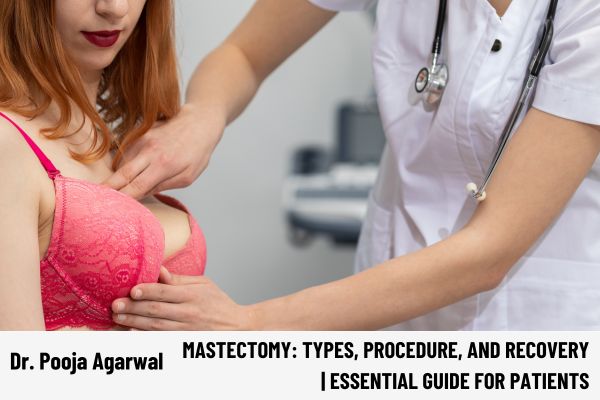Mastectomy: Types, Procedure, and Recovery with Dr. Pooja Agarwal
A mastectomy is a significant surgery performed to treat breast cancer and other related conditions. It involves the removal of one or both breasts, depending on the type of surgery. The procedure may seem overwhelming, but understanding the different types, the surgical process, and recovery expectations can help patients prepare for the journey ahead. In this blog, Dr. Pooja Agarwal, a leading breast cancer specialist, explains the types of mastectomy, the procedure, and what to expect during recovery.
Types of Mastectomy
Mastectomy is not a one-size-fits-all procedure. Depending on the patient’s specific condition and cancer stage, different types of mastectomies can be performed:
- Total Mastectomy (Simple Mastectomy)
The entire breast tissue is removed, including the nipple and areola, but without the removal of lymph nodes. This is often done when the cancer is localized to the breast. - Modified Radical Mastectomy
In this procedure, the entire breast is removed along with the lymph nodes under the arm. It’s typically recommended if the cancer has spread to the lymph nodes. - Radical Mastectomy
This is a more extensive surgery that removes the entire breast, lymph nodes, and chest wall muscles. It is rarely performed today unless there is significant cancer spread. - Skin-Sparing Mastectomy
Only the breast tissue is removed while preserving most of the skin. This is often followed by breast reconstruction for a more natural appearance. - Nipple-Sparing Mastectomy
This procedure preserves the nipple and areola while removing the underlying breast tissue. It’s commonly done when the cancer is not in the nipple area.
The Mastectomy Procedure
The mastectomy procedure involves several key steps that are carefully planned by the surgical team, led by Dr. Pooja Agarwal, to ensure the best possible outcome for the patient.
- Pre-Surgery Consultation:
Before the surgery, Dr. Pooja Agarwal will review the patient’s medical history, discuss treatment options, and determine the most suitable mastectomy approach. - Anesthesia:
The patient is placed under general anesthesia to ensure they are comfortable and pain-free throughout the procedure. - Surgical Removal of Tissue:
The surgeon will make an incision in the breast to remove the affected tissue. The type of incision depends on the type of mastectomy and the size of the breast. - Post-Surgery Care:
After the surgery, a bandage or dressing will be applied to the incision area. Drainage tubes may be used temporarily to help remove any fluid buildup. - Breast Reconstruction (Optional):
Breast reconstruction surgery can be done immediately after the mastectomy or later, depending on the patient’s preference and health condition. This may involve the use of implants or tissue from other areas of the body.
Recovery After Mastectomy
Recovery from a mastectomy is a gradual process, and the timeframe can vary based on the type of surgery, the patient’s health, and whether breast reconstruction is performed. Dr. Pooja Agarwal emphasizes the following key points in recovery:
- Hospital Stay:
Most patients remain in the hospital for 1–2 days after the surgery for monitoring and pain management. - Pain Management:
Pain relief is a priority, and the patient may be prescribed medication to help manage discomfort during recovery. - Wound Care:
Proper care of the surgical site is crucial to prevent infection. Patients will be provided with detailed instructions on how to care for their incision. - Activity Restrictions:
Initially, patients should avoid heavy lifting and strenuous activities. Light activities, such as walking, can usually be resumed after a few days. - Follow-Up Appointments:
Regular follow-up appointments are necessary to monitor healing and ensure that there are no complications, such as infection or recurrence of cancer. - Emotional Support:
It’s common for patients to experience a range of emotions after mastectomy. Seeking support from family, friends, or a counselor can be beneficial for emotional recovery.
Conclusion
A mastectomy is a vital procedure for those diagnosed with breast cancer. While the surgery may seem intimidating, it is often a life-saving treatment. Dr. Pooja Agarwal stresses the importance of early detection, personalized care, and proper recovery for the best outcomes. By understanding the types of mastectomies, the surgical process, and recovery expectations, patients can make informed decisions and take the necessary steps toward healing.
If you or a loved one is considering a mastectomy, consult with Dr. Pooja Agarwal for expert guidance and comprehensive care.

